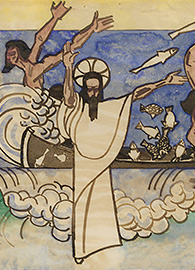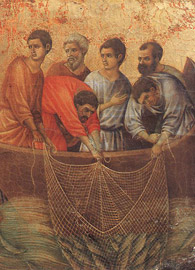John Week 11
Epilogue and Restoration: Joyous New Life (John 21:1–25)
Seattle Pacific University Assistant Professor of New Testament
Read this week’s Scripture: John 21:1–25
13:10
Key Prologue Terms: revelation, children of God, life, testimony, belief
Post-Resurrection Joy

 Enlarge
Enlarge
In C. S. Lewis’s novel, The Lion, the Witch, and the Wardrobe, readers meet the famous lion Aslan. Aslan is the incarnation of Jesus Christ, imagined in a world called Narnia. Like Jesus, Aslan dies in the place of a traitor (Barabbas in John’s gospel; Edmund in Narnia), though both deaths have far-reaching consequences. And like Jesus, Aslan’s supporters feel that his death marks the end of their promise of hope. However, as with Jesus, Aslan’s death is not an end, but a new beginning, as he returns to life and is ultimately victorious over the powers that had bound him in death.
It is interesting to compare Aslan’s resurrection story and appearances to those of Jesus in the Gospel of John. One commonality is that they both appear to women first. Susan and Lucy, two of the children in Narnia, witness Aslan’s death and resurrection. While Mary Magdalene does not witness Jesus’ actual resurrection, she does witness the resurrected Jesus first. However, the children in Narnia frolic and play with Aslan. In this way, Lewis portrays the sheer joy that both the children and Aslan himself have after the resurrection.
While John says that the disciples have rejoiced because they have seen Jesus (20:20), we have not seen them displaying much of that joy beyond Thomas’ confession (20:28). There certainly has not been the playfulness that Aslan enjoys with the children in Narnia. However, things change in John 21. In Jesus’ third resurrection appearance, we find some unusual details.
First, it seems that this part of the gospel is an epilogue: the gospel could have justifiably ended at John 20, and no one would notice anything lacking. Second, the story of Jesus’ appearance to the fishing disciples has a few odd characteristics: Peter is described as though he were fishing naked, and then proceeds to put clothes back on to jump in the water (21:7); Jesus tells the disciples to bring in the fish they have caught for breakfast, but there are already fish cooking on the fire (21:9–10); finally, when the fish are hauled in we learn the most usual detail of the story, that there were 153 fish in the net (21:11).
All of these details are to convey the kind of lightheartedness, the pure joy, that we can experience with the resurrected Jesus, similar to that of Aslan playing with the children in Narnia. Jesus’ resurrection is an occasion for joy, and the story of his appearance on the beach should remind us of this.
Epilogue: Where’s the Ending?
The Gospel of John joins other canonical gospels (especially Mark) in having an unusual ending. John 20 could serve as an entirely appropriate ending to the gospel if we did not have John 21. John 20 concludes with two resurrection appearances in Jerusalem; Jesus commissions the disciples to go out, empowered by the Spirit, for forgiveness and repentance; and the evangelist explains the purpose of the gospel, for faith and life.
Nevertheless, there are no ancient manuscript copies of the Gospel of John that exclude John 21. It does serve as a kind of afterthought or epilogue in some sense, but it fits well with many of the themes of the Gospel of John itself. Furthermore, and perhaps more importantly, John 21 serves not only as the epilogue of the Gospel of John but also as the conclusion of all four gospels with its placement in the canon. In this way, John’s final chapter sums up points about Jesus’ identity and how disciples should follow him within the gospel tradition as a whole, and prepares the reader for the book of Acts.
Fishing in Galilee

 Enlarge
Enlarge
John 21 is the only time in the gospel that John provides his readers with a list of disciples, all of whom (except Thomas) are from Galilee. [Author’s Note 1] While it may seem strange for the disciples to have just met Jesus twice in Jerusalem, and then to decide to go fishing (21:3), John is making a statement about Jesus’ presence here. Jesus is present in their everyday lives just as much as in the magnificent events of his resurrection.
Jesus speaks to the disciples from the lakeside, but they do not know it is he, a delayed recognition that is typical of resurrection stories. By following Jesus’ directions they are able to recoup a night’s empty catch with a net full of fish. It seems that this net full of fish — life where there was no life before — allows the disciple Jesus loved to see that it is Jesus on the lakeshore, and he proclaims, “It is the Lord!” (21:7; cf. 20:18, 20, 28).
Simon Peter’s actions after this proclamation may strike modern readers as a bit odd. The NRSV claims Peter “put on some clothes, for he was naked, and jumped into the sea” (21:7). To put it plainly, why was Peter fishing naked? And if he were, why would he put on clothing and then jump into the sea? It may help to know that the phrase “he was naked” likely means that Peter was not wearing any outer garments. He still would have worn the first century equivalent of an undershirt and shorts: a loincloth and a work tunic. Whether he grabbed his outer garment because he did not want to leave it in the boat, wanted to be more appropriately attired, or was making an allusion to Jesus “putting on” his outer garment after he finished washing the disciples’ feet (cf. 13:12), we certainly get the sense of Peter’s eagerness to see Jesus. [Author’s Note 2] This absentminded joy reminds readers of the footrace in John 20:2–4. As Peter will be a main character for the rest of John 21, it seems logical to focus on him.
Peter: Forgiveness and Commissioning
John’s gospel is the only canonical gospel that concludes with a conversation between Jesus and Peter. In other accounts he may be explicitly singled out (e.g., Mark 16:6–7), but John’s narrative seems appropriately positioned to demonstrate how Peter is forgiven and restored. Even though Peter plays a less prominent role in the Gospel of John, he is still responsible for confessing Jesus’ identity early on in the narrative (Jesus is “the Holy One of God” who has “the words of eternal life;” 6:68–69). Furthermore, his position is quite prominent in the narrative of the early Church, as chronicled in the next book of the canon, Acts. In its canonical context, Jesus’ conversation with Peter prepares the reader for these coming events.
The story itself recalls Peter’s three-fold denial of Jesus (18:15–27). Previously Peter had denied that he knew Jesus while Jesus was confessing his own identity (18:19–24). Now Jesus asks Peter three times if he loves him. Each time Peter replies that he does love Jesus, and Jesus then replies that Peter should care for Jesus’ sheep. Peter is “hurt” by the end of the conversation (21:17), likely because he feels that Jesus has made his point, but also because he knows the third time echoes the disgrace of his denial. Yet Jesus’ words to Peter remain the same: “follow me” (21:19). Jesus does not shame Peter for his actions, but clarifies and restores Peter’s love and commission.
This passage speaks a great deal about love, which is one of the gospel’s key terms (cf. John 13, 15). There are two words for love used in this dialogue:
- Jesus: “Do you love (agapan) me?”
- Peter: “Yes, Lord; you know that I love (philein) you.”
- Jesus: “Do you love (agapan) me?”
- Peter: “Yes, Lord; you know that I love (philein) you.”
- Jesus “Do you love (philein) me?”
- Peter: “Lord, […] you know that I love (philein) you.”
In some contexts in Greek literature agapan and philein are categorized as different types of love, with agapan referring to a godly, unconditional love and philein referring to a friendly kind of love. Nevertheless, the Gospel of John has used these terms virtually interchangeably. [Author’s Note 3] In other words, when Jesus asks Peter if he loves (agapan) him, he’s not asking Peter to do something he theoretically knows Peter can’t do — love like God loves — before ultimately settling on a philein kind of love, a compromise, due to Peter’s humanity or failure. Rather, in every question Jesus is asking Peter whether he loves Jesus as God loves Jesus, and Jesus does not doubt that such love is possible, even for Peter. Each time Jesus is asking Peter if he knows him, believes him, and is willing to follow him, thereby showing his love in action by caring for Jesus’ followers. Is he willing to be a good shepherd like the Good Shepherd he loves? To this Peter says yes, even though his “yes” will lead to his death (21:19).
Peter: Follow Me
Peter also is featured in the final scene of John’s gospel, as is the disciple Jesus loved. This concluding episode reminds readers of the first story in which we met the beloved disciple, namely when Jesus was prophesying his own death with the beloved disciple reclining against him (13:25; cf. 1:18). Despite Jesus’ commands to Peter to be concerned about feeding Jesus’ sheep and following Jesus, Peter voices one last concern about his fellow disciple.
Jesus denies Peter the satisfaction of an answer, and simply repeats his earlier command: “Follow me” (21:22). The gospel carefully clarifies, however, that such an evasive answer by Jesus did not mean that the beloved disciple was to live forever, or even was to live until Jesus’ return (21:22–23). This passage contributes to the church tradition that claims that the beloved disciple lived a long life. At the same time, it also indicates that the beloved disciple had died by the time the gospel was in its final written form.
Such affirmation is echoed in the final verses of the gospel. In these verses we see that the beloved disciple’s primary function, witnessing to Jesus — both declaring who he is (“It is the Lord!” 21:7) and testifying to others — culminates in the testimony of the Gospel of John itself. Nevertheless, given that the final version of the gospel seems to know of the death of the beloved disciple, we can assume that his testimony provided key information for the gospel accounts, but that he did not live to see the final version of the gospel completed (21:24). [Author’s Note 4]
Concluding the Gospel as well as the Gospels
With the final mention of the beloved disciple’s testimony, the Gospel of John concludes by summarizing that “there are also many other things that Jesus did” (21:25), reminding readers that neither John nor the gospel tradition as a whole is meant to be an exhaustive record of Jesus’ life. Furthermore, a constant video stream of Jesus’ life, even if it had been available in the first century, would not actually benefit the church. The purpose of the gospels, like the purpose of Scripture as a whole, is to shape us into people who look more and more like Jesus, having joyous new life in his name. We are now the beloved disciples, providing living testimony that John’s gospel is true.
“In the beginning was the Word, and the Word was with God, and the Word was God” (1:1). “And the Word became flesh and lived among us, and we have seen his glory, the glory as of a father’s only son, full of grace and truth” (1:14). “No one has ever seen God. It is God the only Son, who is close to the Father’s heart, who has made him known” (1:18). “But these are written so that you may come to believe that Jesus is the Messiah, the Son of God, and that through believing you may have life in his name” (20:31).
Questions for Further Reflection
- Prologue “threads,” composed of key prologue terms, are woven throughout the Gospel of John. Think back through our Lectio study. In what ways has this gospel shown that the Word (Jesus) is God? What God-like attributes does Jesus have in this final chapter?
- What instances of post-resurrection joy have you personally experienced?
- What does it mean to have life “in his name” (John 1:12), especially based on this final chapter of John’s gospel?
- What information about Jesus or about being Jesus’ disciple does John 21 give us so that we are ready to turn to Acts and read the story of God’s work in the early church?
<<Previous Lectio Back to John

This work is licensed under a Creative Commons License.




